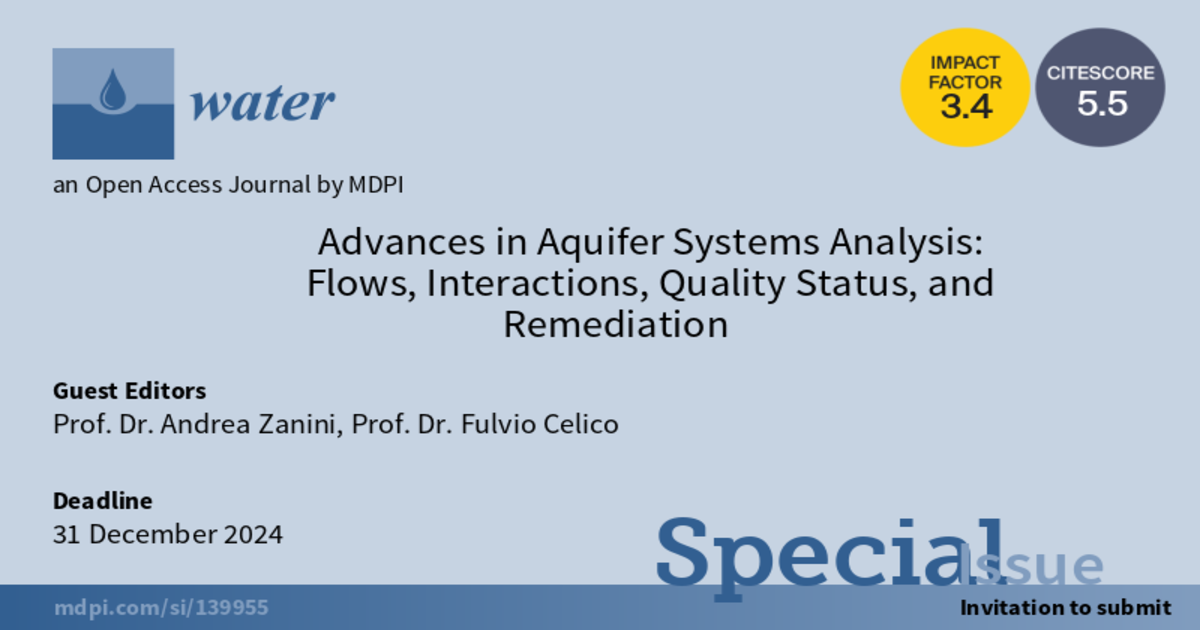- 3.0Impact Factor
- 6.0CiteScore
- 20 daysTime to First Decision
Advances in Aquifer Systems Analysis: Flows, Interactions, Quality Status, and Remediation
This special issue belongs to the section “Hydrogeology“.
Special Issue Information
Dear Colleagues,
The impact of human activities and climate change on groundwater systems is becoming severe. For this reason, the study of aquifer systems is essential for many applications, such as groundwater management, groundwater remediation and geothermal applications. In recent decades, both experimental and numerical techniques have been developed to estimate hydrogeological parameters and to understand groundwater flow and transport processes.
This Special Issue focuses on recent advances and future developments in aquifer system analysis. This involves new advances in the knowledge surrounding the topic of interest. In particular, multidisciplinary approaches are welcome, including chemical isotope and microbiology analyses, numerical modelling, pumping and field test, etc. This includes but is not limited to saturated/unsaturated flow, seawater intrusion, and porous and karst aquifers.
Our aim is for this Special Issue of Water is to provide the readers with multidisciplinary tools that allow for knowledge on aquifer systems to improve.
Prof. Dr. Andrea Zanini
Prof. Dr. Fulvio Celico
Guest Editors
Manuscript Submission Information
Manuscripts should be submitted online at www.mdpi.com by registering and logging in to this website. Once you are registered, click here to go to the submission form. Manuscripts can be submitted until the deadline. All submissions that pass pre-check are peer-reviewed. Accepted papers will be published continuously in the journal (as soon as accepted) and will be listed together on the special issue website. Research articles, review articles as well as short communications are invited. For planned papers, a title and short abstract (about 250 words) can be sent to the Editorial Office for assessment.
Submitted manuscripts should not have been published previously, nor be under consideration for publication elsewhere (except conference proceedings papers). All manuscripts are thoroughly refereed through a single-blind peer-review process. A guide for authors and other relevant information for submission of manuscripts is available on the Instructions for Authors page. Water is an international peer-reviewed open access semimonthly journal published by MDPI.
Please visit the Instructions for Authors page before submitting a manuscript. The Article Processing Charge (APC) for publication in this open access journal is 2600 CHF (Swiss Francs). Submitted papers should be well formatted and use good English. Authors may use MDPI's English editing service prior to publication or during author revisions.
Keywords
- groundwater
- numerical modelling
- contaminant transport
- groundwater remediation
- multidisciplinary approach
- water resources
- climate change
- aquifer recharge

Benefits of Publishing in a Special Issue
- Ease of navigation: Grouping papers by topic helps scholars navigate broad scope journals more efficiently.
- Greater discoverability: Special Issues support the reach and impact of scientific research. Articles in Special Issues are more discoverable and cited more frequently.
- Expansion of research network: Special Issues facilitate connections among authors, fostering scientific collaborations.
- External promotion: Articles in Special Issues are often promoted through the journal's social media, increasing their visibility.
- e-Book format: Special Issues with more than 10 articles can be published as dedicated e-books, ensuring wide and rapid dissemination.

